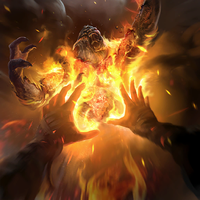Lore:Destruction
The school of Destruction is one of the six schools of magic. It is largely concerned with dealing damage to living and non-living forms of matter, and making said matter more vulnerable to such damage, though some spells of this school can even damage or drain non-physical targets such as attributes or skills. The straightforward and nature of Destruction has been a cause of academic dissent throughout history by those who see it as crude or simple, while masters of the art defend it for its practicality and depth.[1] Study of Destruction magic is known to involve the theory of emotional-magicka response and volitional interference factors,[2] and requires a deeper consideration of spell delivery method than other schools. Mastery of Destruction may bring a certain amount of danger to its caster.
Types of Destruction Magic[edit]
Destruction magic boils down to five basic types: elemental damage, value-draining, value-damaging, vulnerability, and disintegration.
- Elemental damage uses fire, frost, shock, or (rarely) poison to inflict damage directly. These may be fired directly at targets, but some applications have utilized these forces to be set off by proximity runes, or used a form of protective cloak, or even a damaging wall of magical energy to deter opponents. Practitioners of fire magic are known as Pyromancers,[3] practitioners of ice magic are known as Cryomancers,[4] and practitioners of storm magic are known as Electromancers.[5]
- Value-draining magic attacks a creature's body by temporarily reducing one of its fundamental statistics. This may be used to attack a skill, such as ability with a sword or proficiency in acrobatics, or an attribute, such as a creature's luck or agility. It may be used to make a creature tired by attacking its fatigue or it can be used to drain a creature's health or magicka reserves. Whatever value is attacked, it returns to its previous value once the magical effect wears off.
- Value-damaging magic works similarly to value-draining magic. It targets the same values, but the effect remains after the spell's duration is over. The resulting damage must be cured using Restoration magic.
- Vulnerability spells make the target more susceptible to other forms of damage. This includes not only elemental damage, but also damage from weapons, poison and even magic itself. It can even be used to make the target more vulnerable to disease.
- Disintegration spells only attack equipment: armor or weapons. However, some skilled wizards have learned to disintegrate the entire bodies of foes through mastery of shock magic.
Although these are the basic types of effect, other effects such as the damage inflicted by the sun upon vampires are often studied by mages skilled in Destruction magic. Many diseases can be viewed as a form of Destruction magic. Curses are a form of Destruction magic. [6]
History[edit]
Sometime between late 3E 399 and 3E 426, an Illusionist named Berevar Bero gave a speech in the Imperial City in which he suggested that the School of Destruction is not a true school and should be merged into the School of Alteration. After Bero decided to have the speech printed and it caught the attention of academics, a battlemage named Malviser delivered a particularly stinging rebuke.[6] In 3E 431, the Council of Mages decided that Destruction magic in Cyrodiil was to become the responsibility of the guildhall in the town of Skingrad.[7]
See Also[edit]
- Game-specific information for Daggerfall, Morrowind, Oblivion, and Skyrim.
- For an overview of how Destruction spells have changed throughout the series, see the General article on Magic.
Books[edit]
- Destruction or Distraction by Humius Acidinus — A criticism against the trend of excessive intellectualism in magical study
- The Liturgy of Affliction by Anias Gae (transcribed) — A Collection Of The Writings Of Vexis Velruan
- Mora'at's Theory of Lightning by Mora'at the Lesser, Wizard of Corinthe — A Mages Guild theory on the inner workings of shock spells
- On the Utility of Shock Magic by Vanus Galerion — Archmage Galerion's notes on the flexibility of shock magic
- Oshgura's Destruction Journal by Oshgura — An Orcish sorcerer's journal recounting his difficulty learning spells
- Response to Bero's Speech by Malviser, Battlemage — Commentaries of "Bero's Speech to the Battlemages" book
